Step -by -step guide for building a hoop house
Building our Hoop House-Kas was a process of combining creativity, usability and many practical activities. Here is how we brought it all together, step by step:
1. Prepare the site
Before we started putting together the hoop house, we selected a level with good exposure to sunlight. Preparing the site included cleaning up debris, the leveling of the soil and ensuring that there was enough space for the footprint of the greenhouse.
2. Anchoring the frame
The recycled metal carport frame was the backbone of our greenhouse. To safely anchor it, we placed 4x4s directly on the ground. The frame was attached to the 4x4s with sturdy brackets and screws, so that it would not switch or wiggle in strong winds. The 4x4S not only stabilized the structure, but also offered a solid foundation to attach other components such as the wooden ends.
3. Construct the wooden ends
We have built the wooden ends using finished plywood cladding that we bought at the Home Depot. This cladding gave the greenhouse a clean, polished look and added strength and insulation to the structure. The wooden ends were a crucial part of strengthening the overall greenhouse and creating safe openings for the doors and windows. The process involved:
-
- Each ends with vertical and horizontal wooden supports to create a solid foundation for the façade cladding.
- Attach the finished multiplex façade cladding to the frame, ensuring that everything was tightly protected and weather -resistant.
- Make cutouts for the front and back doors, as well as small windows on the front for extra ventilation.
- Anchoring the wooden ends safely to the carport frame and the 4x4s for extra stability.
The plywood cladding not only added the durability, but also made the greenhouse more professional and coherent. It was a great investment that improved both the functionality and the appearance of the structure.
4. Install the doors
For the front door we used a heavy door of the service door that we had set up, adjustment by replacing the screens with Kas Plastic. This was an easy and cost -effective solution that a professional look has added. The back contained double doors, framed in wood and covered with the same brooika plastic. These provide wider access when needed, especially for bringing in supplies or equipment.
5. Cover the structure with plastic
We used 6 million cash plastic from the plastic delivery of farm to cover the carport frame. This plastic is sustainable, UV-resistant and rated up to a maximum of four years, making it an excellent choice for the project. To ensure that it was tight, evenly distributed and securely attached, we used a channel lock and wiebeldraad system from Bootstrap Farmer. Here is how we did it:
-
- The plastic was carefully draped over the carport frame and ensured that it was even and free of wrinkles.
- The channel lock was installed along the edges of the frame and the wiggle wire was used to tighten the plastic tightly in place. This system made it easy to adjust the plastic if necessary and ensured a strong, weather -resistant position.
- Cut around the wooden ends and we fit the plastic precisely, where we protect it with the channel lock and the wobble wire for a professional and sturdy finish.
The channel locking and selection wire system was an investment, but it is invaluable to keep the plastic safe even during strong wind. It is a simple, effective solution that ensures that the coverage will remain in place for years.
6. Add ventilation
Ventilation is essential for regulating temperature and humidity in the greenhouse. We have installed a heat -related exhaust fan on one of the wooden ends. It is automatically switched on when the temperature rises and ensure that the plants do not overheat inside. This is an addition that I highly recommend for each greenhouse.
7. Preparation for the future
Although the greenhouse is already functional, we have plans to further improve it:
-
- Adding ground stone floors for improved drainage and simpler cleaning.
- Installing a diesel heating to maintain heat during the coldest nights, especially for starting and spending plants of seed.

